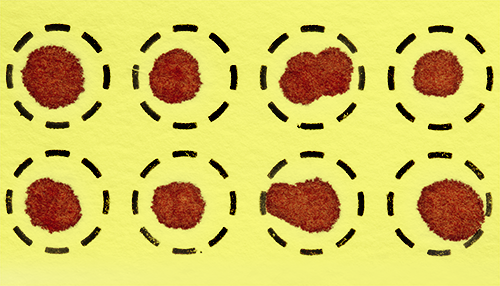New Sample Preparation Products and Accessories 2020
This yearly report on new products introduced in the preceding year, since May 2019, covers sample preparation instrumentation, supplies, and accessories.
This yearly report on new products introduced in the preceding year, since May 2019, covers sample preparation instrumentation, supplies, and accessories.
New sample preparation technologies introduced in the past year were more bountiful than in previous years. Most product introductions were aimed at improved performance of existing technologies, or aimed at specific applications. Sorbents and accessories for solid-phase extraction (SPE) led the way, as did automated, multiplatform integration of sample preparation.
Our annual review of sample preparation products covers the previous year. In late 2019, the LCGC staff submitted a survey to vendors of sample preparation products. Responses to this survey are compiled in this review, as are new product introductions observed during the past 12 months. Additionally, after a keyword search (using the terms “sample preparation equip”, “extraction equipment”, “blend/grind/mix/shake/stir”, “evaporators/evaporation”, “filtration and purification”, and “pipettes/pipetters”) of the online Pittcon 2020 vendor list, each of these vendors were visited during the conference.
This review is presented in three sections. First, SPE sorbents and products are discussed. Next, advances in automated, multiplatform systems are presented. Finally, attention is turned to other sample preparation accessories and supporting technologies. To assist the reader with some of the details behind these new products, each section presents a tabular summary of the associated products. In all cases, the new products we uncovered are presented in the annotated table, while the text highlights particularly worthwhile products.
Solid-Phase Extraction
Mixed-mode SPE has been gaining in popularity in recent years. Phenomenex introduced a new product in that space, under its Strata line, combining reversed-phase sample cleanup and matrix removal. The Strata-X Pro SPE is available in cartridge (1, 3, and 6 mL) and 96-well plate or microelution formats. The company claims time savings of up to 40% via elimination of the conditioning and equilibration steps. Table 1 summarizes the Strata-X Pro, and other SPE products.
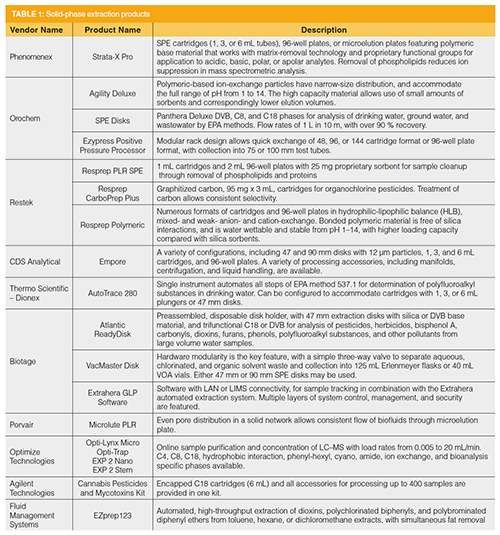
Orochem introduced two families of SPE products. The Agility Deluxe line of polymeric ion-exchange products is based on divinylbenzene (DVB) with strong- or weak- cation- or anion-exchange capabilities, and is available in cartridge, plate, and microelution formats. The company also introduced a series of SPE disks, featuring its Panthera Deluxe reversed-phase DVB. The thin disks with high sorbent capacity allow fast flow rates and use less elution solvent. The disks are designed for pesticides, herbicides, polychlorinated biphenyls (PCBs), polycyclic aromatic hydrocarbons (PCAHs), and total petroleum hydrocarbons (TPHs) from aqueous samples.
Restek introduced several new products in its Resprep SFE line for method-specific performance. The Resprep PLR SPE is available in cartridge and well-plate formats, with proprietary material for sample cleanup. SPE materials feature graphitized carbon for organochlorine pesticide cleanup in soil and water, CarboPrep adsorbent for general utility use, EPH silica for petroleum hydrocarbons, florisil for pesticides, and a multipurpose silica. A novel co-sintered frit design, with the proprietary sorbents immobilized into the rigid, porous structure, allows a stabilized sorbent with high manufacturing control and performance uniformity.
CDS Analytical acquired the Empore line from 3M during the past year. Styrene-DVB ion-exchange disks and cartridges and 96-well plates with C8, C18, styrene-DVB ion exchange, and a universal resin are available. The key feature of the original disk format is trapping of the sorbent particles within an inert matrix of polytetrafluoroethylene (PTFE) for a denser, more uniform extraction bed.
Biotage developed the Atlantic ReadyDisk as single-use (disposable) disks with silica or DVB base material and trifunctional C18 or DVB for absorption or sample cleanup of aqueous samples according to the EPA 500, 600, or 8000 series methods.
Porvair Sciences announced the Microlute PLR as a next generation microplate for phospholipid and protein removal from plasma and serum samples.
Trapping columns for liquid chromatography and mass spectrometry (LC–MS) analysis were introduced in a variety of dimensions by Optimize Technologies. Opti-Lynx Micro, Opti-Trap, Exp 2 Nano, and Exp 2 Stem traps are placed into LC injector valves for sample concentration or purification. Various sizes accommodate a range of load rates and a number of phases are available.
With the growing interest in cannabis testing, due to legalization of medicinal marijuana and industrial hemp, Agilent developed cannabis pesticide and mycotoxin testing kits consisting of 6-mL SPE cartridges and associated consumables. The kits include consumables for processing 400 samples and method guidelines.
In addition to SPE products, instrumentation to support or perform SPE was also introduced throughout the year. With the acquisition of the Empore SPE products, CDS Analytical introduced a number of related SPE processing equipment. For example, for working with 96-well plates, positive pressure and vacuum manifolds, centrifuges, and liquid handling robots are available. Orochem also introduced a family of positive-pressure processors under the Ezypress name. Sorbent bed drying, as well as faster analyte processing, are the advantages of this processing mode, especially with viscous samples.
At the end of March 2020, Thermo Scientific-Dionex came out with the AutoTrace 280 per- and polyfluoroalkyl substances (PFAS)SPE instrument. The system is designed to simultaneously process up to six water samples according to EPA method 537.1 in 2 to 3 h, with only about 15 min of manual intervention. Minimization of PTFE-coated components reduces the risk of interferences.
The Biotage VacMaster Disk is an SPE unit with a single port vacuum manifold to assist extraction of aqueous samples. Multiple units, up to eight, can be combined in parallel. Existing vacuum pumps can be used, and any disk holder or cartridge with luer fittings are allowed. Suggested applications of the VacMaster include EPA methods 625.1, 1664B, and 8270. Biotage also developed the Extrahera GLP software to manage the good laboratory practice (GLP) workflow with audit trail tracking.
The EZprep123 from Fluid Management Systems processes six samples in parallel in less than 45 min for the isolation of dioxins, polychlorinated biphenyls, and polybrominated diphenyl ethers (PBDEs). This system is a companion to the EZSPE for water and waste water analysis, and the EZPFC for the extraction of polyfluorinated compounds in water and waste water.
Automated, Multiplatform Instrumentation
Given the number of steps in a typical sample preparation scheme (1), the role of automated, multiplatform instrumentation is of strong interest to suppliers of chromatography and sample preparation materials, and to the end users working at the laboratory bench. However, defining which sample preparation steps to include, and development of such equipment at an affordable cost, remain significant hurdles in this area. As such instrumentation continues to emerge, issues of reproducibility, labour intensity, and laboratory safety are addressed. The past year saw important new products in this area.
Last year, Markes International introduced the Centri, a multiplatform sampling and concentration system for gas chromatography. This year, an expansion of the Centri platform was presented.
Trap-enabled preconcentration, extraction, and enrichment makes the system attractive to a wider range of laboratories. High capacity sorptive extraction, headspace sampling, thermal desorption, and solid-phase microextraction (SPME), including the SPME Arrow, allow collection and concentration of a broad range of volatile and semivolatile organic compounds. On-board diagnostics accommodates system self-checking. Table 2 presents a compilation of the automated, multiplatform product introductions. Improvements are also noted in the CTC Analytics PAL3 system, particularly in the area of automation. Smart SPME fibers contain a microchip to monitor extraction parameters and usage history. Polydimethylsiloxane (PDMS), acetate, DVB, and carbon fibre coatings are available. The Smart chip is also used in SPME Arrow and liquid handling syringes. The Sirius Automation MicroTasker is a modular platform with a laboratory information management system interface featuring vial sorting and weighing, liquid handling, capping and uncapping, and barcode reading.

Sample Preparation Accessories and Related Products
The field of sample preparation is very broad, and, coupled with the fact that there are any number of established and emerging technologies identified as sample preparation, commercial developments and new product introductions are often in seemingly scattered areas. An attempt is made here to unify these varied product offerings.
Magnetic Bead Extractions
Isolation of analytes via dispersion of an SPE-like particle is widely used and enhanced when magnetic particles are used. Phenomenex introduced bioZen streptavidin-coated paramagnetic beads, as depicted in Figure 1. The bead is activated with a biotinylated capture antibody to prepare for immunocapture of monoclonal antibody targets. After analyte isolation, the beads are recovered from the liquid sample by magnetic attraction. Table 3 provides an overview of the sample preparation accessories and related products.
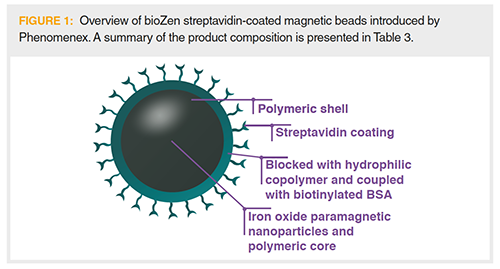
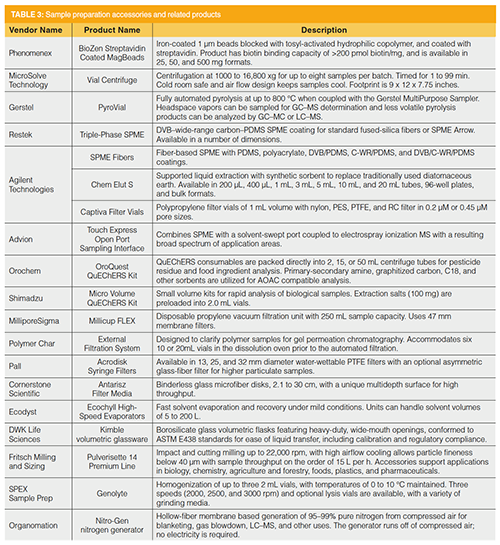
Centrifugation
While standard centrifuges are available for test tubes and well-plates, MicroSolve Technology developed the Vial Centrifuge for use with 12 x 32 mm glass autosampler vials for applications in metabolomics, LC–MS, and bioanalysis. Heavy-walled glass vials have 1.2 or 1.8 mL capacity, and an air-flow system keeps the sample cool during centrifugation.
Pyrolysis
The Gerstel PyroVial was introduced to the European market this past year, and is slated for release in other geographies. The PyroVial performs at up to 800 °C, and can be used as a microscale reaction chamber prior to LC–MS or GC–MS analysis.
Solid-Phase Microextraction
While SPME featured prominently in the automated, multiple-platform instruments previously discussed, stand-alone SPME products were also featured this year. Restek developed a triple-phase coating with DVB, carbon, and PDMS in standard fibre and SPME Arrow formats. A broad selectivity range allows analysis via headspace sampling or direct immersion.
Agilent also developed a family of SPME fibres to complement its SPME Arrow line. Applications include the determination of a variety of environmental pollutants from water samples using a wide selection of stationary phase coatings.
Advion worked with Oak Ridge National Laboratory to create the Touch Express Open Port Sampling Interface, which uses a low volume, open port of continuously swept solvent that flows directly into its Expression compact mass spectrometer. Direct assays, screening, and large molecule determinations are possible.
QuEChERS
QuEChERS, the quick, easy, cheap, effective, rugged, and safe extraction technique originally created for the screening of pesticide residues in produce, continues to spawn new product introductions for food safety and other applications. Orochem developed a family of QuEChERS products designed for AOAC method 2007.01 products or specialty areas like fruits, pigmented proteins, hemp, and stevia.
Shimadzu also created a QuEChERS kit designed for microscale analysis of biological or forensic samples. The Micro Volume kits use only 100 mg of extraction salts preloaded into 2.0 mL tubes.
Supported Liquid Extraction
Supported liquid extraction combines features of liquid–liquid extraction with the surface area advantages of SPE. Agilent has been a major player in this field, and this year introduced Chem Elut S with a synthetic sorbent to replace diatomaceous earth supports. This more-consistent support material is available in 96-well plate, cartridge, and bulk formats. Applications include removal of salts and phospholipids from sample matrices.
Filtration
A number of filtration products were introduced in the past year. Agilent produced the Captiva Filter Vials with nylon, PES, PTFE, and RC filters in 0.2 µm or 0.45 µm pore sizes. The product will allow easier and faster filtration of LC or GC samples than using syringes, syringe filters, or standard vials.
MilliporeSigma created a disposable polypropylene vacuum filtration unit for sample processing.
Polymer Char’s External Filtration System is an automated device for eliminating carbon black, catalyst residue, and other small particles in polymer samples. The apparatus extends the lifetime of in-line filters and gel permeation columns and reduces noise in light scattering detectors.
Pall introduced water-wettable PTFE membranes in its Acrodisk syringe filter line designed to protect LC columns from particulate build-up.
Cornerstone Scientific presented the Antarisz filter media, glass microfibre disks for botanical extracts.
Solvent Recovery
Ecodyst marketed a family of Ecochyll high-speed solvent evaporators to aid solvent recovery in extraction laboratories. Models range from 5 to 200 L, and are energy efficient. Volatile or gaseous solvents, like butane or carbon dioxide, can be accommodated along with traditional organic solvents.
Volumetric Glassware
We are all familiar with volumetric glassware, but Kimble advanced the state-of-the-art with the first ever heavy-duty, wide-mouth flasks that reduce glass-to-glass contact during dilution workflows. ISO-certified manufacturing and flasks covering the standard range of volumetric flasks are available, with tight tolerances for accuracy and precision.
Grinding and Homogenization
Particle size reduction is often needed in the preparation of solid and semi-solid samples to shorten diffusion pathways for extraction, and to increase sample homogeneity. Recent new products in this area include the Pulverisette 14 line from Fritsch. This new sample grinder combines impact and cutting mill processes, with uniform production of particles down to 40 µm. The inclusion of pre-grinding and fine grinding into a single unit allows comminution of soft to medium hard, brittle, fibrous, and temperature-sensitive materials.
SPEX introduced the Genolyte multipurpose homogenizer to accommodate plant and animal tissues, seeds, soils, minerals, and other samples in 2–12 mL vials. Sample temperatures between 0 and 10 °C are maintained.
Gas Generators
Organomation introduced the Nitro-Gen nitrogen generator. This instrument uses a hollow-fibre membrane to convert compressed air into 95–99% pure nitrogen gas. The generator couples with any of the company’s gas blowdown evaporators.
Conclusion and Future Directions
No clear trends in new product introductions were readily observed, which is unsurprising, given the diversity of the field. On that basis, one can only expect the trend in coming years to be some combination of tool building and problem solving for bioanalysis, food, environmental, and related areas.
References
- D.E. Raynie, LCGC Europe29(3), 142–152 (2016).
Douglas E. Raynie “Sample Prep Perspectives” editor Douglas E. Raynie is a Department Head and Associate Professor at South Dakota State University, USA. His research interests include green chemistry, alternative solvents, sample preparation, high-resolution chromatography, and bioprocessing in supercritical fluids. He earned his PhD in 1990 at Brigham Young University under the direction of Milton L. Lee. Raynie is a member of LCGC’s editorial advisory board. Direct correspondence about this column via e-mail to LCGCedit@mmhgroup.com
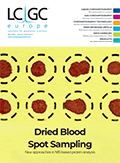
A Matrix-Matched Semiquantification Method for PFAS in AFFF-Contaminated Soil
Published: April 14th 2025 | Updated: April 14th 2025Catharina Capitain and Melanie Schüßler from the Faculty of Geosciences at the University of Tübingen, Tübingen, Germany describe a novel approach using matrix-matched semiquantification to investigate per- and polyfluoroalkyl substances (PFAS) in contaminated soil.
Silvia Radenkovic on Building Connections in the Scientific Community
April 11th 2025In the second part of our conversation with Silvia Radenkovic, she shares insights into her involvement in scientific organizations and offers advice for young scientists looking to engage more in scientific organizations.


